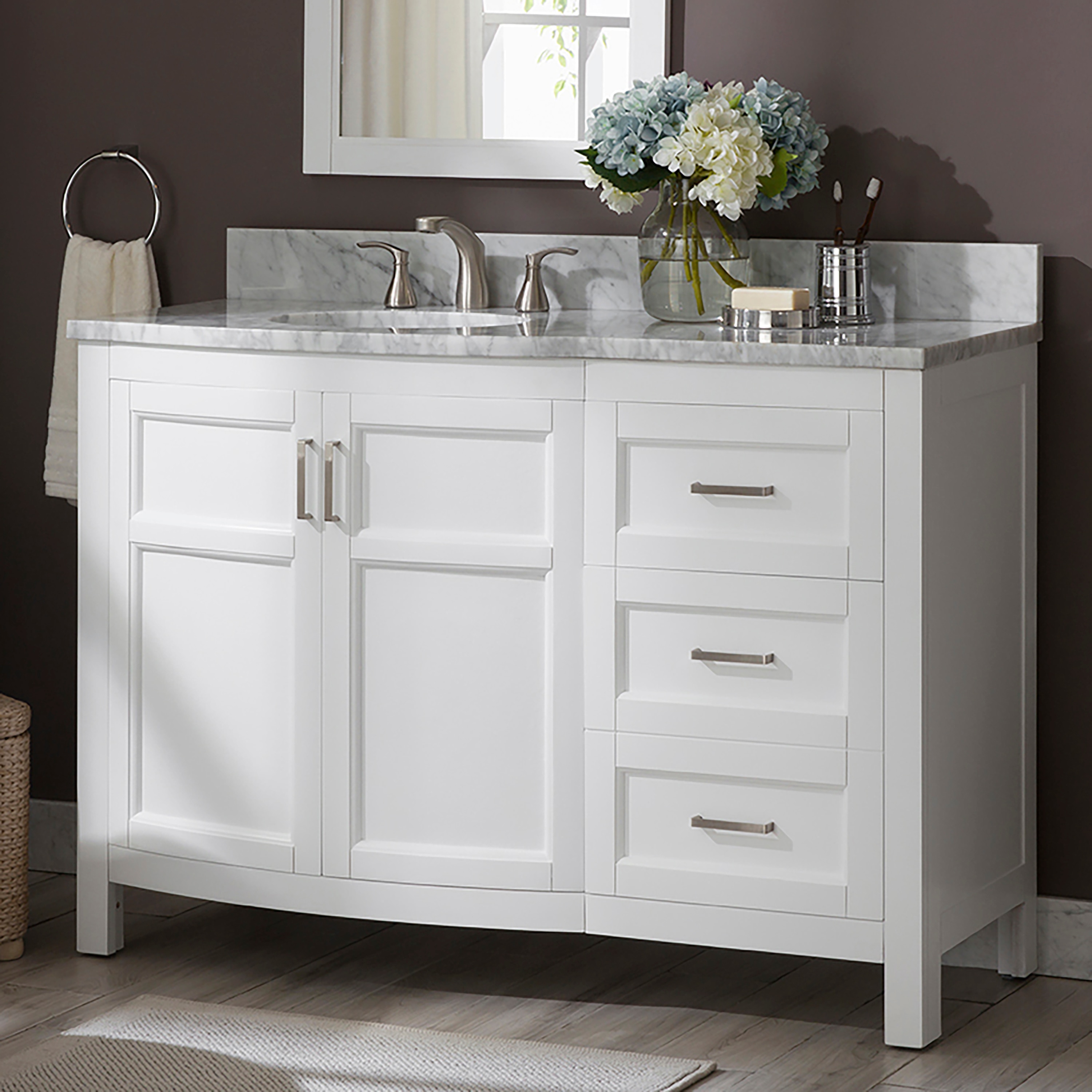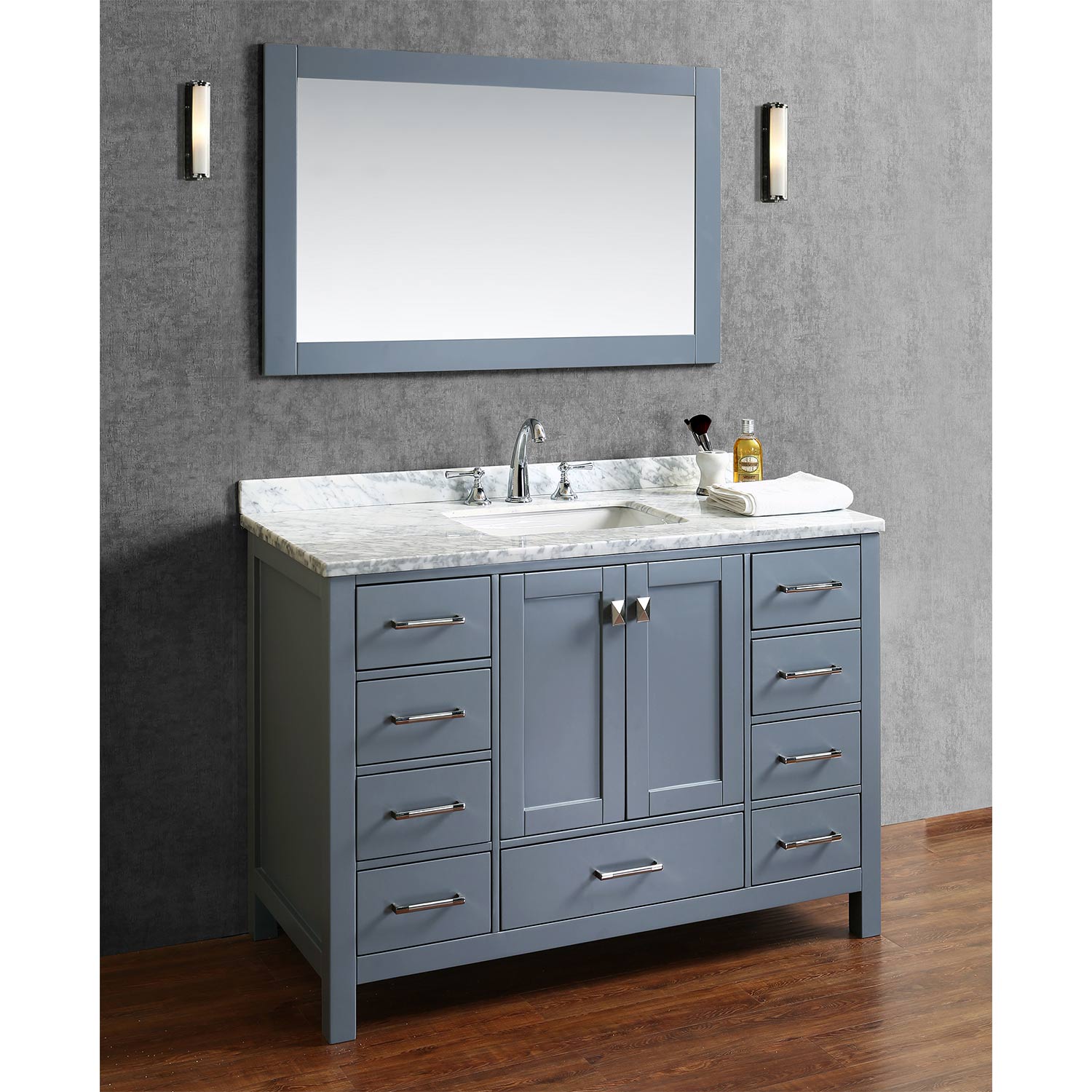Types of Bathroom Vanities

A 48-inch bathroom vanity is a common size that can accommodate a variety of styles and designs. Whether you prefer a traditional, modern, contemporary, or farmhouse aesthetic, there’s a vanity out there to suit your taste. This section will delve into the different styles, materials, and features of 48-inch bathroom vanities, helping you make an informed decision for your bathroom remodel.
Vanity Styles
The style of your bathroom vanity is a key design element that sets the overall tone of your bathroom. Here are some of the most popular vanity styles:
- Traditional: Traditional vanities are characterized by their classic and elegant design, often featuring intricate details, ornate hardware, and warm wood tones. They typically have a more formal appearance, with features like raised panels, fluted legs, and decorative molding.
- Modern: Modern vanities prioritize clean lines, minimalist aesthetics, and a focus on functionality. They often feature sleek, geometric shapes, bold colors, and high-gloss finishes. Materials like metal, glass, and acrylic are commonly used in modern vanities.
- Contemporary: Contemporary vanities share some similarities with modern styles, but they often incorporate more organic shapes, natural materials, and a softer aesthetic. They tend to have a more relaxed and inviting feel, often incorporating elements like wood grains, stone accents, and subtle curves.
- Farmhouse: Farmhouse vanities embody a rustic charm, often featuring distressed wood, exposed beams, and a focus on natural materials. They typically have a more casual and inviting feel, often incorporating elements like open shelving, farmhouse sinks, and wrought iron hardware.
Materials, Bathroom vanities 48 inches wide
The material of your bathroom vanity is important for both its aesthetics and durability. Here are some common materials used in vanity construction:
- Wood: Wood is a popular choice for bathroom vanities due to its natural beauty, durability, and versatility. Common wood species used in vanities include oak, maple, cherry, and walnut. Wood vanities can be stained or painted to match your bathroom’s décor.
- Marble: Marble is a luxurious and elegant material that adds a touch of sophistication to any bathroom. It is known for its unique veining patterns and durability. However, marble is porous and requires regular sealing to prevent stains.
- Granite: Granite is another durable and elegant material that is often used for bathroom countertops and vanities. It is known for its hardiness, resistance to scratches and heat, and wide variety of colors and patterns.
- Laminate: Laminate is a cost-effective and durable material that mimics the look of natural materials like wood or stone. It is easy to clean and maintain, making it a popular choice for busy bathrooms.
Vanity Features
48-inch bathroom vanities come with a variety of features that can enhance their functionality and aesthetics. Here are some common features:
- Drawers: Drawers provide ample storage space for toiletries, towels, and other bathroom essentials. They can be organized with dividers or trays to keep everything in its place.
- Cabinets: Cabinets offer additional storage space for larger items like towels, linens, and cleaning supplies. They can be accessed with doors or drawers, depending on the design.
- Shelves: Shelves provide open storage for frequently used items, such as hand towels, decorative items, or toiletries. They can be made of wood, glass, or metal.
- Countertops: The countertop is a key feature of any bathroom vanity. It should be durable, easy to clean, and aesthetically pleasing. Common countertop materials include marble, granite, quartz, and laminate.
Choosing the Right Vanity
A 48-inch bathroom vanity offers ample storage and countertop space for most bathrooms. However, with various styles, materials, and features available, choosing the right vanity for your needs can feel overwhelming. This guide will help you navigate the process, from understanding the differences between vanity features to selecting the right countertop material.
Vanity Features
The features of a bathroom vanity play a significant role in its functionality and aesthetics. Here’s a comparison of the pros and cons of different features:
| Feature | Pros | Cons |
|---|---|---|
| Drawers vs. Cabinets |
|
|
| Open Shelves vs. Closed Storage |
|
|
Factors to Consider When Choosing a 48-Inch Vanity
Selecting a 48-inch bathroom vanity involves several considerations to ensure a perfect fit for your space and style:
- Bathroom Size: Measure the available space carefully, considering the vanity’s width, depth, and height. Allow enough room for comfortable movement around the vanity and for opening doors and drawers.
- Personal Style: Choose a vanity that complements your bathroom’s overall design and style. Consider the color, finish, and material of the vanity to match your preferences.
- Budget: Set a realistic budget for your vanity, factoring in the cost of the vanity itself, countertop, sink, and installation.
- Storage Needs: Consider the amount of storage space you need. If you have a lot of bathroom essentials, choose a vanity with ample drawers, cabinets, or shelves.
- Countertop Material: Choose a countertop material that is durable, easy to clean, and aesthetically pleasing. Popular options include granite, quartz, marble, and laminate.
- Sink Style: Select a sink style that complements the vanity and your preferences. Popular options include undermount, vessel, and drop-in sinks.
- Faucet Style: Choose a faucet that complements the vanity and sink. Consider the style, finish, and functionality of the faucet.
Measuring the Bathroom Space
Accurate measurements are crucial for ensuring the vanity fits properly. Here’s how to measure your bathroom space:
- Measure the width of the available space: Measure the space where you plan to install the vanity, including any obstructions like pipes or walls.
- Measure the depth of the available space: Ensure the vanity’s depth fits comfortably without encroaching on the bathroom’s walking area.
- Measure the height of the available space: Consider the vanity’s height in relation to the height of your bathroom fixtures and the overall design of the space.
- Measure the distance from the vanity location to the nearest electrical outlet: Ensure the vanity has enough space for electrical connections, such as for a light fixture or a power outlet.
- Measure the distance from the vanity location to the nearest plumbing supply line: Ensure the vanity has enough space for plumbing connections, such as for the sink and faucet.
Selecting the Right Countertop Material
Countertop materials are a crucial aspect of bathroom vanity design. Here are some popular options and their pros and cons:
- Granite: A natural stone known for its durability, scratch resistance, and heat resistance. It comes in a wide range of colors and patterns. Pros: Durable, heat resistant, scratch resistant, unique patterns. Cons: Expensive, requires sealing, can be porous.
- Quartz: An engineered stone made from quartz crystals and resin. It is non-porous, stain-resistant, and durable. Pros: Non-porous, stain resistant, durable, wide range of colors. Cons: Can be expensive, may not be as heat resistant as granite.
- Marble: A natural stone known for its elegance and beauty. It is softer than granite and quartz, so it requires more care. Pros: Elegant, unique patterns, can be polished to a high shine. Cons: Soft, easily scratched, requires regular sealing, susceptible to stains.
- Laminate: A synthetic material made from layers of paper impregnated with resin. It is a budget-friendly option that is available in various colors and patterns. Pros: Budget-friendly, easy to clean, wide range of colors and patterns. Cons: Not as durable as natural stone, can be susceptible to scratches and heat damage.
Installing a 48-Inch Bathroom Vanity: Bathroom Vanities 48 Inches Wide

Installing a 48-inch bathroom vanity is a project that can significantly enhance your bathroom’s aesthetic appeal and functionality. While it may seem daunting, with proper planning and careful execution, it is a task that most DIY enthusiasts can accomplish successfully. This guide will walk you through the essential steps, ensuring a smooth and efficient installation process.
Preparing the Area
Before starting the installation, it is crucial to prepare the area adequately. This involves clearing the space around the intended location of the vanity, ensuring there is enough room to work comfortably. You should also remove any existing fixtures or plumbing, such as the old vanity, sink, and faucet. It’s a good idea to turn off the water supply to the bathroom at this stage to prevent any accidents. The next step is to check the existing plumbing and electrical connections to ensure they are compatible with the new vanity. If necessary, you may need to adjust the plumbing or electrical lines to match the new vanity’s specifications. Finally, before starting the installation, make sure the floor is level and clean. This will ensure that the vanity is installed correctly and securely.
Connecting Plumbing
Once the area is prepared, you can start connecting the plumbing. The first step is to connect the water supply lines to the vanity’s faucets. Ensure the water supply lines are compatible with the faucet’s connections. The next step is to connect the drain pipe to the vanity’s drain. Make sure the drain pipe is properly sealed to prevent leaks. If necessary, you may need to adjust the drain pipe’s position to match the vanity’s drain location. It is crucial to ensure all plumbing connections are secure and leak-free before proceeding.
Securing the Vanity
With the plumbing connected, you can now secure the vanity to the wall. The vanity should be level and plumb before securing it. Use a level to ensure the vanity is straight and even. Use the appropriate screws or bolts to secure the vanity to the wall studs. Ensure that the screws or bolts are long enough to penetrate the wall studs for maximum stability. Once the vanity is secured to the wall, you can attach the vanity top.
Installing the Vanity Top and Sink
Installing the vanity top and sink is a straightforward process. The vanity top is typically secured to the vanity base using clips or brackets. Ensure that the vanity top is level and properly aligned before securing it. Once the vanity top is in place, you can install the sink. Most sinks are secured to the vanity top using a sealant and clamps. Ensure the sink is properly aligned and centered before securing it. After installing the sink, you can connect the faucet. Ensure the faucet is properly tightened and secured to the sink. Finally, turn on the water supply and check for any leaks.
Ensuring the Vanity is Level and Stable
Ensuring the vanity is level and stable is essential for a successful installation. A level vanity will prevent water from pooling around the base, while a stable vanity will ensure it remains secure and functional. Use a level to check the vanity’s horizontal and vertical alignment. Adjust the vanity’s legs or feet as needed to ensure it is level. Once the vanity is level, ensure it is securely fastened to the wall. Use appropriate screws or bolts to attach the vanity to the wall studs for maximum stability.
Connecting the Vanity to the Plumbing System
Connecting the vanity to the plumbing system is a crucial step in the installation process. The first step is to connect the water supply lines to the vanity’s faucets. Ensure the water supply lines are compatible with the faucet’s connections. The next step is to connect the drain pipe to the vanity’s drain. Make sure the drain pipe is properly sealed to prevent leaks. If necessary, you may need to adjust the drain pipe’s position to match the vanity’s drain location. It is crucial to ensure all plumbing connections are secure and leak-free before proceeding.
